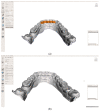Mechanical Properties of 3D Printed Orthodontic Retainers
- PMID: 35565167
- PMCID: PMC9100403
- DOI: 10.3390/ijerph19095775
Mechanical Properties of 3D Printed Orthodontic Retainers
Abstract
Orthodontic retention is the final important stage of orthodontic treatment, the aim of which is to consolidate the functional and aesthetic position of teeth. Among adults, fixed retainers made of different types of wires are the most common. The aim of this study was to analyse the mechanical properties of a new generation of fixed orthodontic retainers-printed by 3D printers.
Materials and methods: The study was conducted using samples made of Nextdent MFH C&B N1 resin in the form of cuboid bars with nominal dimensions of width b = 3 mm, thickness d = 0.8 mm; 1 mm; 1.2 mm, length l = 30 mm for each type. The influence of the thickness of the retainers on their strength under loaded conditions was evaluated. Flexural strength, elastic properties, deflection, and creep were compared. The samples were aged in an artificial saliva bath at 37 ± 1 °C during the strength tests.
Results: It was shown that differences in the thickness of the samples affected their elastic and strength properties. The highest average flexural modulus, the highest deflection, creep, and strength was characteristic of the samples with the highest thickness (1.2 mm). Samples with an average thickness of 1 mm had the lowest modulus of elasticity.
Conclusions: The mechanical properties of 3D printed retainers show that they can be an alternative to metal retainers and the procedure of making new retainers, especially when patients have aesthetic requirements or allergies to metals.
Keywords: 3D printing in orthodontics; CAD/CAM in orthodontics; aligner; digital orthodontics; lingual retainer.
Conflict of interest statement
The authors declare no conflict of interest.
Figures






Similar articles
-
Direct 3D-Printed Orthodontic Retainers. A Systematic Review.Children (Basel). 2023 Apr 3;10(4):676. doi: 10.3390/children10040676. Children (Basel). 2023. PMID: 37189925 Free PMC article. Review.
-
Effect of post-processing on the surface, optical, mechanical, and dimensional properties of 3D-printed orthodontic clear retainers.Clin Oral Investig. 2025 Jan 6;29(1):48. doi: 10.1007/s00784-024-06120-4. Clin Oral Investig. 2025. PMID: 39760896 Free PMC article.
-
The Influence of Thickness on the Mechanical Behaviors of 3D Printing Resins for Orthodontic Retainers.Int J Biomater. 2024 Jun 25;2024:7398478. doi: 10.1155/2024/7398478. eCollection 2024. Int J Biomater. 2024. PMID: 38957572 Free PMC article.
-
Biofilm formation of Streptococcus mutans, Streptococcus sanguinis, Staphylococcus epidermidis, Staphylococcus aureus, Lactobacillus casei, and Candida Albicans on 5 thermoform and 3D printed orthodontic clear aligner and retainer materials at 3 time points: an in vitro study.BMC Oral Health. 2024 Sep 18;24(1):1107. doi: 10.1186/s12903-024-04893-4. BMC Oral Health. 2024. PMID: 39294648 Free PMC article.
-
Transforming orthodontic retention: potential of 3D printing and biocompatible material characteristics.J Med Eng Technol. 2025 Jan;49(1):8-33. doi: 10.1080/03091902.2025.2466198. Epub 2025 Feb 20. J Med Eng Technol. 2025. PMID: 39976311 Review.
Cited by
-
Evaluation of the physical and mechanical properties of 3D-printed resin for orthodontic fixed lingual retainers: An in vitro study.J Dent Sci. 2025 Jul;20(3):1723-1730. doi: 10.1016/j.jds.2025.03.034. Epub 2025 Apr 10. J Dent Sci. 2025. PMID: 40654449 Free PMC article.
-
Accuracy of soy-based resins for dental 3D printing.Angle Orthod. 2024 Sep 1;94(5):574-580. doi: 10.2319/112523-779.1. Angle Orthod. 2024. PMID: 39230023 Free PMC article.
-
A Novel 3-Dimensional Printed Nanoceramic Hybrid Resin Fixed Lingual Retainer: Characterization and Mechanical Tests.Int J Dent. 2024 Oct 15;2024:3540846. doi: 10.1155/2024/3540846. eCollection 2024. Int J Dent. 2024. PMID: 39445113 Free PMC article.
-
Clinically Relevant Properties of 3D Printable Materials for Intraoral Use in Orthodontics: A Critical Review of the Literature.Materials (Basel). 2023 Mar 8;16(6):2166. doi: 10.3390/ma16062166. Materials (Basel). 2023. PMID: 36984045 Free PMC article. Review.
-
Direct 3D-Printed Orthodontic Retainers. A Systematic Review.Children (Basel). 2023 Apr 3;10(4):676. doi: 10.3390/children10040676. Children (Basel). 2023. PMID: 37189925 Free PMC article. Review.
References
-
- Domagała I., Gil L., Firlej M., Pieniak D., Selech J., Romek D., Biedziak B. Statistical Comparison of the Hardness and Scratch-Resistance of the PMMA Polymers Used in Orthodontic Appliances. Adv. Sci. Technol. Res. J. 2020;14:250–261. doi: 10.12913/22998624/127437. - DOI
MeSH terms
LinkOut - more resources
Full Text Sources
Miscellaneous

